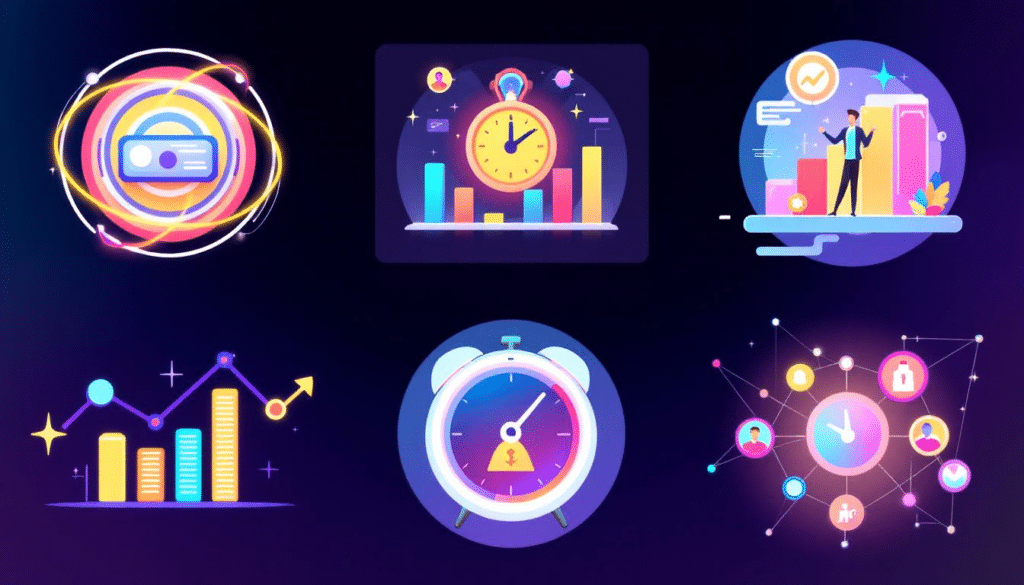Micro credentials, or what are micro credentials, are short, specialized qualifications focused on specific skills. Unlike traditional degrees, they are quick, affordable, and targeted, making them ideal for those looking to enhance their resume or stay updated with industry trends. In this article, we’ll explore how micro credentials work, their types, and their benefits.
Key Takeaways
- Micro credentials are short, targeted qualifications focusing on specific competencies, offering a flexible and affordable alternative to traditional degrees.
- They provide a transparent verification system through digital badges that signify proficiency in particular subjects, enhancing employability and career mobility.
- As recognition from employers grows, particularly in sectors like business and finance, micro credentials are increasingly seen as valuable for job applications and skill enhancement.
Understanding Micro Credentials

Micro credentials are qualifications that focus on specific competencies. They are shorter in duration compared to traditional comprehensive certifications. They allow for bite-sized chunks of knowledge to be studied within a short time frame, making them highly accessible and efficient. Also known as nanodegrees, the goal of micro credentials is to allow individuals to gain skills on-demand without lengthy commitments.
These credentials are particularly targeted at professionals seeking to enhance their resumes and keep up with industry trends. They offer opportunities for continuing professional development and focus on specific professional skills, unlike certificates which provide more general knowledge.
Their flexibility and affordability attract a wide range of learners, allowing them to customize their learning experience to fit their personal and professional needs.
How Micro Credentials Work
Micro credentials consist of a series of courses culminating in a digital badge that signifies proficiency in a particular subject. These digital badges are embedded with metadata that detail the criteria and evidence needed to earn the micro-credential, providing a transparent and verifiable record of achievement.
Gaining a micro credential might include completing assignments, attending lectures, and presenting portfolios. These credentials are designed to be short, focused learning experiences that provide specific skills, making them more accessible and affordable than traditional degrees. This method enables learners to showcase their skills with evidence and is tailored to meet individual professional needs.
Micro credentials provide a flexible approach to professional development, enabling self-paced and self-monitored learning. One of their key advantages is flexibility, allowing learners to balance their studies with personal and professional commitments.
Types of Micro Credentials
Designed for quick completion, often within six months, micro credentials focus on specific subject areas. Various types of micro credentials cater to different learning needs. Introductory micro credentials cover fundamental concepts and skills, suitable for beginners. For instance, Oregon State offers both introductory and advanced micro credentials to address diverse learning needs.
Advanced micro credentials provide in-depth training and often require prior knowledge or prerequisite courses. They are ideal for professionals aiming to deepen their expertise in a particular field.
Stackable micro credentials consist of bite-sized courses that can be combined to create a comprehensive portfolio of qualifications in a subject area. This modular approach allows for a customized learning path that can evolve with the learner’s career goals.
A variety of micro credentials ensures that educational institutions and organizations can cater to everyone, regardless of current skill level or career aspirations.
Benefits of Micro Credentials

Numerous benefits make micro credentials an attractive option for learners. They are fast, flexible, customizable, often on demand, and significantly less expensive than traditional education options. While traditional degrees typically take several years, micro credentials can be completed in just weeks or days.
These credentials provide an efficient approach to expanding skills and increasing employability, especially for professionals with full-time jobs. They enable immediate learning of career-relevant skills, contributing to an impressive CV and enhanced educational experiences through professional learning and lifelong learning.
Their shorter duration also enables quicker transitions into new roles or advancements in current careers. The cost-effectiveness of these programs makes them accessible to a broader audience, further supporting career mobility.
Flexibility in Learning
Flexible learning environments provided by micro credentials adapt to individual learners’ needs. Unlike traditional degrees with rigid timelines, micro credentials let students demonstrate skills at their convenience. Such flexibility benefits working professionals or those with other commitments, enabling them to balance studies with personal and professional lives.
Learning at one’s own pace and focusing on specific skills makes micro credentials excellent for those seeking to gain advanced skills without disrupting daily routines. This competency-based approach helps learners achieve their educational and career goals more efficiently.
Skill Enhancement
Micro credentials align with market demands, ensuring the skills taught are relevant and in demand. This makes micro credentials particularly valuable for professionals seeking to enhance their skill set and remain competitive in the job market.
Employers often report that the most significant hiring challenge for recent graduates is the need for specific skills. Micro badges can represent individual skills or be combined into pathways for micro credentials, enhancing their value by recognizing multiple skills and competencies.
Career Mobility
They assist individuals in advancing their careers by providing targeted skills and qualifications. Although earning a micro credential does not guarantee a promotion or raise, it can significantly enhance one’s resume and career prospects, depending on state policies and company practices.
These programs can reduce turnover and improve organizational efficiency, supporting employee retention and enhancing company branding. A significant percentage of U.S. students believe that micro credentials will aid their career success, highlighting their potential impact on career mobility.
Recognition of Micro Credentials by Employers
Recognition of micro credentials by employers is growing rapidly. A survey indicated that 86% of U.S. employers believe micro credentials enhance job applications. Many employers value micro credentials because they directly address specific skill shortages, making candidates more attractive for hiring.
Most employers likely recognize micro credentials, particularly in business, marketing, and finance sectors. However, some employers may not yet be familiar with the terminology. This unfamiliarity could lead to misunderstandings in communication. External validation, such as accreditation from recognized universities, indicates the quality of a micro credential. Employers tend to value micro credentials from accredited institutions more than those from less established providers.
Students can showcase their earned micro credentials on platforms like LinkedIn, enhancing their visibility to potential employers. Engaging with employers involved in credential development can enhance the value of a micro credential and provide job opportunities.
Examples of Popular Micro Credentials

Numerous popular micro credentials are widely recognized across various sectors. For example, the Certified Clinical Medical Assistant micro credential is well-regarded in healthcare. The Online Teaching Fundamentals micro credential prepares educators for virtual instruction, an increasingly important skill.
Other examples include the Financial Literacy micro credential, focusing on essential finance skills for everyday life, and the Project Management micro credential, equipping professionals with project management skills.
External micro badges like the IC3 Digital Literacy Certification and CompTIA A+ certification also demonstrate competency in specific technical skills. These examples highlight the diverse applications and recognition of micro credentials in today’s job market.
Micro Credentials vs Traditional Degrees

They offer a shorter, more targeted approach to skill development compared to a traditional degree. Online courses are more specific, cheaper, and can be completed in less time. This makes them attractive for those seeking to quickly acquire new skills without the financial and time commitments of a full degree program.
While traditional degrees remain valuable, they often lack the flexibility of micro credentials. At least 6 credits are required for a micro credential, making them a substantial yet manageable commitment.
Online certificates are narrower in scope compared to micro credentials, which typically require 9 to 12 quarter credits. This flexibility and specificity make micro credentials integral to the modern job market.
Choosing the Right Micro Credential
Assess your career objectives to determine the skills needed for your desired job when choosing the right micro credential. Consider personal career aspirations and available options when deciding on the right micro credential. Evaluate your personal life situation to ensure the selected micro credential fits your current circumstances.
If unsure about your goals after exploring micro credentials, seeking expert guidance can be beneficial. Students pursuing micro credentials often have opportunities to tailor their education to specific interests or career goals.
Whether choosing a certificate program or a micro credential, acquiring new skills for your career is a step in the right direction.
How to Earn and Use Micro Credentials

Earning micro credentials is similar to pursuing traditional coursework and can be rigorous. Initially, individuals must select a skill and view the corresponding micro credential. After completing the necessary assignments and assessments, they can earn micro credentials.
Upon completion, individuals can showcase their micro credentials on resumes and platforms like LinkedIn, enhancing their visibility for job prospects. These credentials are typically certified through digital certificates that can be added to CVs or personal portfolio.
Share your micro credential with evaluators, on social media, and add it to your resume to maximize its impact.
Summary
In conclusion, micro credentials offer a modern, flexible, and efficient way to acquire new skills and stay competitive in today’s job market. They provide targeted learning experiences that are shorter, more affordable, and more accessible than traditional degrees. By understanding how micro credentials work and recognizing their benefits, you can make informed decisions about your professional development and career growth.
Frequently Asked Questions
Micro credentials are concise, competency-based qualifications that enable individuals to acquire specific skills efficiently and flexibly. They offer a practical alternative to traditional education by focusing on skill mastery.
Micro credentials are earned by completing a series of targeted courses, resulting in a digital badge that demonstrates your proficiency in a specific skill or subject. This structure allows for focused learning and validation of expertise in a concise format.
Micro credentials are increasingly recognized by employers, particularly when they come from accredited institutions and align with specific skill demands. This acknowledgment reflects the growing importance of targeted skills in the job market.
Choose the right micro credential by assessing your career objectives and personal circumstances while seeking expert guidance to ensure it aligns with your goals.v













